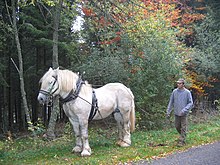Back horse
When skidding horse is called a the forest for wood back employed horse for transfer from felled tree trunks and delimbed the next forest road or Polterplatz , called Vorliefern . Cold-blooded animals are mainly used for the wooden back.
After being largely displaced since the 1960s by the use of agricultural tractors or special forest tractors or forwarders for moving wood, the use of back horses is currently being increasingly propagated again in the course of near-natural forestry . One of the benefits of backing with the horse is that you don't need any back lanes even in rough terrain (e.g. mountains) , but can pull the goods to be skimmed through the standing wood. Furthermore, it is a considerable advantage that, unlike heavy forest machines, they cause practically no soil damage.
Requirements for the back horse
Because of the high demands on the physical strength of the animals when working backwards in heavy wood assortments, mostly cold-blooded breeds with a body weight of 700 kg or more are used in professional use . Nevertheless, not only the heaviest breeds are used, because, for example, in mountainous areas a rather stocky, medium-weight backhorse is more suitable due to its better agility. Especially in the small wood harvest, lighter back horses are used, which are used, among other things, to bring the harvested trees to the harvester who processes them. With this combination, driving on the forest floor can be significantly reduced.
The horse should be in view of the ever-changing soundscape for example by breaking twigs show a quiet character possible, but must be at the same time necessarily zugwillig and Depth Rating, due to the similarly constantly changing draw resistances at Skidding.
Equipment for backing wood
Due to the strongly changing, often jerky, considerably increasing tensile resistance on the back, the animal is usually harnessed with a kumt . Instead of leather straps, chains or sturdy ropes are often used as pull cords to the log , to which the load is attached with a forest chain , at least in the rear section, which can drag across the ground or past obstacles. The log should have a swivel so that the pull chain does not untwist and the log can jump. The use of blinkers in the bridle is avoided, so that the horse can always fully orientate itself in the face of the many obstacles in the forest. The manner in which the horse is guided by humans is different. In some cases, closed leashes are used as when driving a horse-drawn carriage, but these have the disadvantage that on the one hand the horse handler can get tangled in it and the leash itself often gets stuck in the undergrowth. In the Rhineland and Westphalia it was common in the past to walk alongside the horse with a short rope attached to a bridle ring. In southern Germany, on the other hand, the use of the push cord was more common. The push leash, which is also called Zopp , Zupf or Hottleine , is a combination of a short strap or rope that runs from bridle ring to bridle ring, similar to a riding rein, and a single, wide strap attached to it by means of a freely moving ring behind the horse reaching rope or belt. When using the push leash, the back horse must be trained to walk on the left when picking up the leash and right when tugging on the leash, in conjunction with the voice commands that are also important for the other variants.
Other animal species
On the Indian subcontinent, elephants are used to back wood.
literature
- Michael Koch: Traditional work with horses . Ulmer, Stuttgart 1998, ISBN 3-8001-7383-2
Web links
Individual evidence
- ↑ See the situation in Germany, France, the Netherlands and Switzerland and with regard to soil protection: Strong horses - International magazine for the promotion of work with horses and other draft animals , Strong horses Verlag Erhardt Schroll, Lemgo, ISSN 1439-815X , issue 1 / 09, p. 34ff. Edition 2/08, p. 12ff. and issue 1/10, p. 79ff.
- ↑ Julia Wirth and Dirk Wolff: Comparison of horse and rope tractor use when delivering full trees; Retrieved from www.waldwissen.net on November 12, 2017
- ^ Strong horses - International magazine for the promotion of work with horses and other draft animals , Strong Horses Verlag Erhardt Schroll, Lemgo, ISSN 1439-815X , issue 2/08, p. 30ff.


